Basketball Plays - 2-3 Zone Offense Plays
By Dr. James Gels, From the Coach’s Clipboard Basketball Playbook"Helping coaches coach better..."
Disclosure: This page contains affiliate links, which means that Coach's Clipboard receives a small commission (at no cost to you) if you make a purchase using these links.

First read Zone Offense and 2-3 Zone Offense. Mostly we attack zones with a general zone offense and just work that offense. Usually that is all we need to do, as long as we execute well and are patient, make the zone shift, and work the ball inside.
But at times, we will run a set zone play to get someone open for a good shot, whether an inside shot or a 3-pointer. In teaching our system, we first teach our basic zone offense(s), and then add a few of these plays as the season progresses.
You can screen the zone. An effective method is to swing the ball to one side and then, as the zone shifts, back-screen the weakside of the zone. With any of these plays, if the play breaks down, O1 should recognize this and resume your usual zone offense. Also, an important part of any zone offense or zone play is offensive rebounding. Get those second and third shots!
Set plays for attacking the 2-3 zone:
"Carolina"
This play is designed to attack the 2-3 zone from the back-side of the zone, using a skip pass and screening the back-side of the zone. Younger kids may have difficulty making the long skip pass and might find "Zone-1X" below a better alternative.O1 passes to O2 (diagram A) and this causes the zone to shift. O5 slides down into the weakside corner. O3 back-screens the outside low zone defender so that O5 is open for the skip pass from O2.
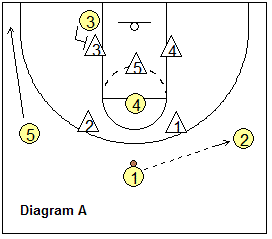
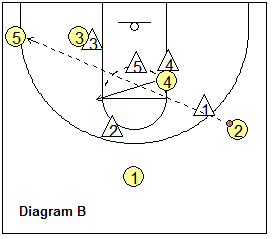
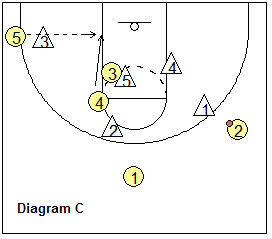
As the pass is being made, O4 cuts to the ball-side elbow (diagram B). Once the pass is made, O3 lets the outside defender slip by out to the corner and O3 now screens the middle defender in the zone. O4 cuts off O3's screen to the block for the pass and lay-up (diagram C).
Zone-1 "X"
This play is similar to Carolina above but without the long skip pass, and younger teams would find this easier to run. Sometimes the middle low defender will cheat up to the high post to guard O4 and the 2-3 zone now looks more like a 2-1-2. This play takes advantage of that. O1 dribbles to the right to engage the outside top defender. O3 screens the outside low defender while O2 slides down to the corner. O1 passes to O2.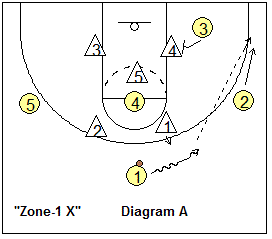
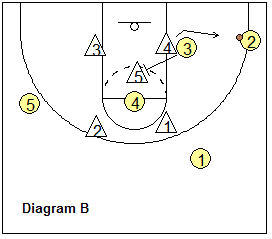
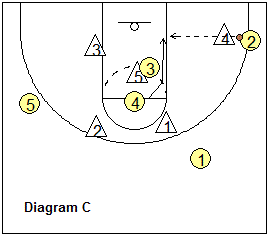
O3 allows the defender to slip outside (diagram B), and then O3 screens the middle defender in the zone. O4 cuts around O3's screen for the pass from O2 and the layup (diagram C).
"91"
Use this play if your point guard is a good shooter. "91"is part of our "90 Series" that we run against man-to-man defense. We can also run a simplified "91" against the 2-3 zone.O4 and O5 move up to the top. O1 passes to either O4 or O5 (can run it right or left). The opposite post (in this case O4), back-screens for O1. O1 flares to the wing. Meanwhile the ball-side wing O2 moves inside to clear the wing for O1, and this also keeps the X4 defender down low.
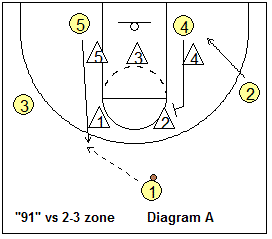
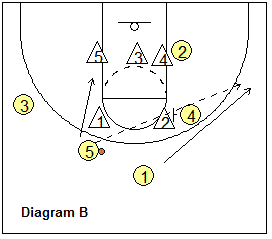
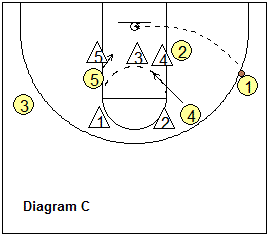
The pass goes over the top to O1 on the wing, and assuming O4 makes a good screen, O1 will almost always be wide open for the outside shot. This is because of a fault in the zone itself. Versus the zone, when O4 moves up top to screen, usually no defender will move up with O4 and this results in no defender being up there to switch on the back-screen. This ensures O1 is wide open.
After passing, O5 moves inside to rebound, as does O4. O3 rotates to the point.
"Corners 52"
We run this play out of a 4-out zone offense, our "Corners" offense. O1 passes to O2 (diagram A), while O5 slides up and screens X2. O3 slides down to the corner. O4 cuts underneath the zone to the ballside block. O2 dribble-penetrates the seam (diagram B), looking for (1) the pull-up jumper, or (2) the pass to O3 in the corner (if X3 drops inside), or (3) the pass to O4 cutting underneath the zone (if X5 comes up to defend).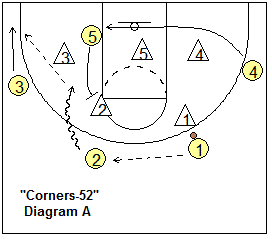
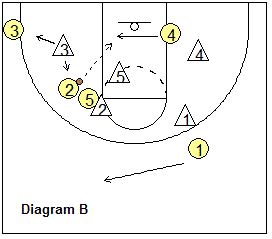
"45" (or "54")
Sometimes our "Zone-2 ("Runner")" offense works well against the 2-3 zone. And we can run "45" (to the right side) or "54" (to the left side) against the 2-3 zone. In "45", the pass goes to O2 in the right corner. O4 makes two screens.The play starts with O4 screening the outside low defender X4 so that the pass can go to O2. After the pass is made, O4 lets X4 get around the screen and as X4 moves out to the corner O4 screens the middle-defender in the zone X5. This frees O5 for a cut to the ball-side low post and the lay-up.
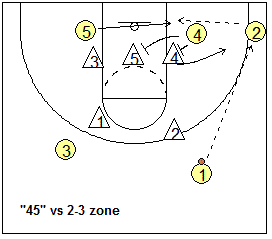
In "54", it's all the same, except on the opposite side with the pass going into the left corner. O2 runs the baseline to the left corner for the pass. O5 sets the inside screen and O4 cuts to the ball-side low post for the pass and lay-up.
"Chicago"
Submitted by Coach Ken Sartini, Arlington Heights, ILHere is another play attacking the 2-3 zone defense. Having an athletic O3 who can jump and finish inside is key. See the diagrams below. O2 sets up on the left wing, v-cuts and gets the pass from O1. O5 and O4 set up below the defense.
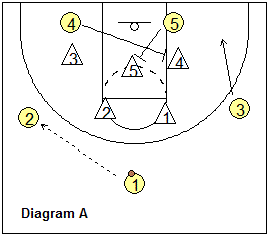
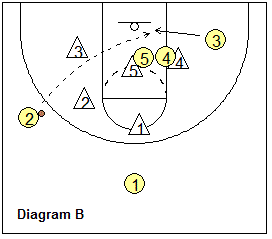
O5 back-screens the middle defender (X5), while O4 back-screens the weak-side low defender (X4). By crossing O4 and O5, we get better screening angles on both screens. O3 slides below the screens for the lob pass from O2, and possible dunk. Or if unable to dunk, O3 catches the pass, gathers and scores off the glass.
"Miami"
There is also a man-to-man version of this play. O1 passes to O3 (diagram A) and they exchange as O1 moves to the left wing, and O3 dribbles to the top. The initial pass to O4 curling around O2 is less likely to be open against the 2-3 zone (but could be open against a 1-2-2 zone). O4 mainly becomes a screener.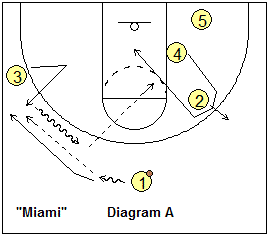
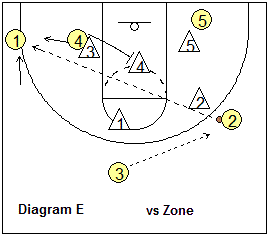
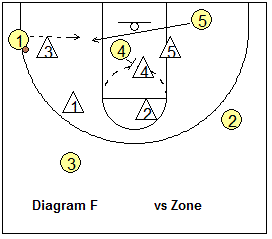
After cutting, O4 moves to the left short-corner area (diagram E). O3 passes to O2. O4 pin-screens the weakside low defender X3, and O2 skip passes to O1 who has dropped down toward the left corner. This causes the low outside defender to run out to defend O1. O4 will bump and delay the X3 defender just enough to make the skip pass to the corner open. Then O4 lets the X3 defender move out to defend, and now O4 screens the middle low defender. O5 cuts underneath for the pass from O1 and the power lay-up.
"Vermont"
Use this simple play vs the 2-3 zone defense for an easy inside jump-shot. Start with a low double stack set (diagram A), with guards O2 and O3 on the left lane line, and post players O4 and O5 on the right lane line. Put your intended shooter (here O5) as the low person in the stack.O2 cuts under to the right corner, while O3 cuts out to the left wing. O4 pops out to the right wing and gets the pass from O1. O4 looks at our good shooter O2 in the corner (diagram B) and might even pass fake (to get X3 aware of O2), but instead reverses the ball back to O1. We want X1 guarding O1, and O1 takes a couple dribbles left (diagram C). O2 cuts up to the wing (to occupy X3), as O4 sets a down-screen on the X5 defender. O5 curls around the screen for the pass from O1, and the inside jump-shot.
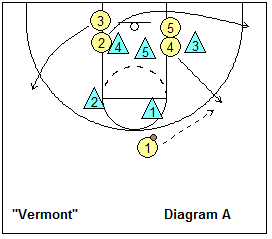
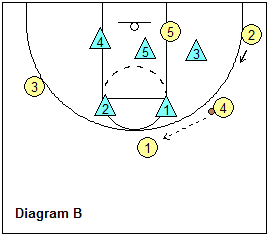
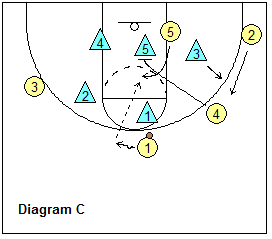
"Special"
From Eric Flannery, this 2-3 zone play starts with a double low stack (diagram 1). You can run it to either side and this is determined by the point guard dribbling to either wing. As O1 dribbles to the right wing, O2 cuts hard under O3 and O5's double-screen (screening the outside low zone defender X3). O1 could pass to our shooter O2 for the corner shot.After screening for O2, O5 and O3 then screen the middle zone defender X5 (diagram 2). The opposite post player O4 cuts around the double-screen for the pass inside from O1, and a lay-up.
If the inside pass is not open, the screening post player O5 flashes to the ballside elbow (diagram 3) for the pass from O2 (or O1), and now O5 and O4 can play hi-lo action, with O5 looking to pass inside to O4. O3 goes to the opposite wing.
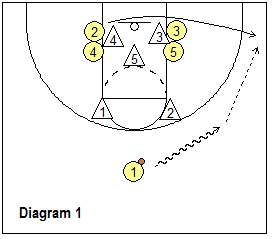
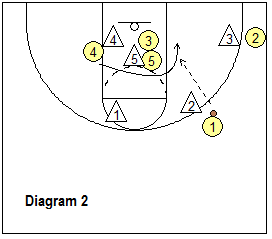
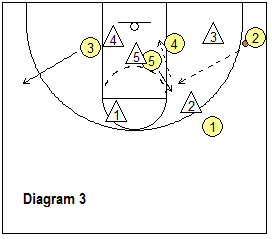
The next three diagrams show the play running to the left side, with O1 dribbling to the left wing (diagram 4). O3 cuts to the ballside corner for a possible pass and shot. O5 is the inside cutter around the O2-O4 double-screen (diagram 5). If the cutter O5 is not open, O4 flashes to the ballside elbow (diagram 6).
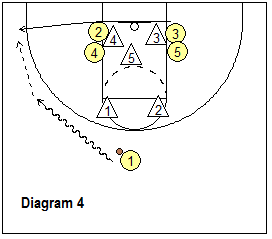
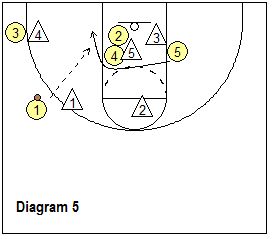
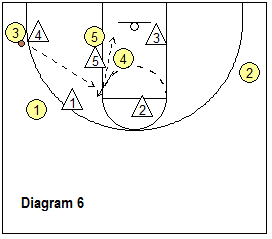
"Special-Down"
This play starts with the same low double stack seen in "Special" (diagram 7). However, this time O2 and O3 criss-cross and cut to the opposite corners, staying low and below the free-throw line extended (so that the low outside zone defender will have to come out to defend). O1 dribbles to either wing and passes to the corner. The ballside post player O5 immediately finds and seals the middle zone defender X5. We look to make the quick pass to O5 inside for the post move and shot.
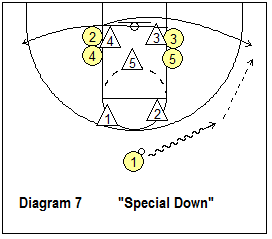
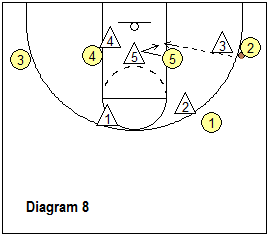
"West"
From Lindsay Gottlieb (University of California Women's Head Basketball Coach), this 2-3 zone play gets you either an open 3-point shot for your best shooter, or a quick basket inside. You can run it to either side. If time on the clock is not a factor, O1 passes to O2 and then O2 passes back to O1 (to get the zone to shift). If time is a factor, skip these first two passes and get right into the play. O3 drops down toward the baseline (diagram 1).O1 dribbles a little to the left and O2 cuts underneath (diagram 2) and through to the left corner-wing area for a possible pass from O1 and a shot.
Meanwhile, O5 screens the middle low defender (X5), and O3 screens the opposite low defender (X4). O4 cuts under the two screens to the ballside block. If the X3 defender moves outside to cover O2, then the quick pass from O1 to O4 is open for a lay-up (diagram 3). If X3 stays inside, O2 has the open 3-point shot, or might feed the post inside.
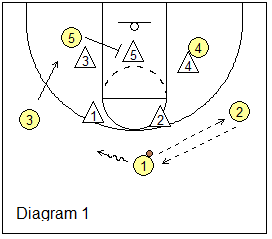
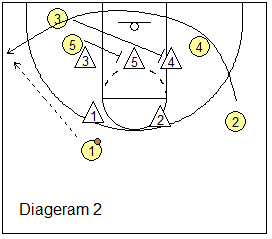
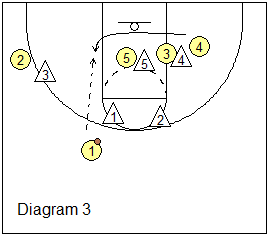
"West" - from DVD "Lindsay Gottlieb: Attacking Zone Defenses with Continuity Offenses & Quick Hitters"
"X-Screen Lob"
From Florida Gators head coach, Mike White, this 2-3 zone play gets you a lob pass to your big man O5. O1 passes to O2 (diagram 1). O2 holds the ball for a moment, allowing the zone to shift. On the pass to O2, O3 and O4 will "x-screen" the two top defenders. O3 sprints over and screens X2 outside, and O4 screens X1, thereby opening a lane for O1 to dribble-drive (diagram 2).O2 passes back to O1, and O2 cuts underneath and back-screens the X4 defender. O5 cuts under this back-screen to the hoop. O1 dribbles middle and this causes the middle defender X5 to come up to stop the ball. O1 lob passes to O5 for the lay-up or dunk (diagram 3).
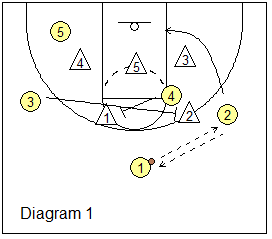
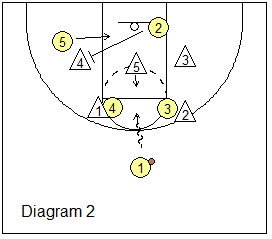
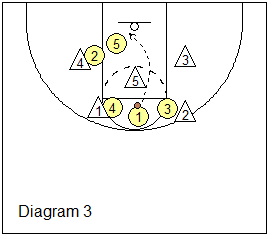
3 "Stack" Plays
From Bryce Drew, Vanderbilt University Head Coach, here are three stack play variations. All three plays start with O4 and O5 stacked on the left low lane area (diagram 1A). O3 starts at the right short corner area. O1 passes to O2, and O2 passes back to O1 to get the defense to shift. O3 cuts under O4-O5 to the left wing-corner area, and this gets the X3 defender to move out. Now here are three options (see the video below)."Stack-1"
First option - after getting the pass back from O2, O1 dribbles left (diagram 1A). O5 screens the middle zone defender X5 (diagram 1B), and O4 cuts into the open gap for a pass from O1 and a 10-foot turn-around shot.
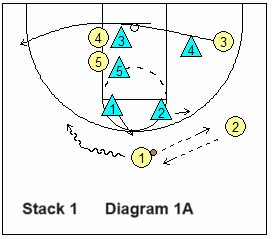
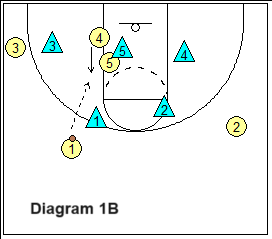
"Stack-2" - lob pass for O5.
This option starts the same way (diagram 2A), except O1 does not dribble left. This time O4 back-screens the middle zone defender X5 (diagram 2B). O5 cuts around the screen for a two-handed overhead lob pass from O1.
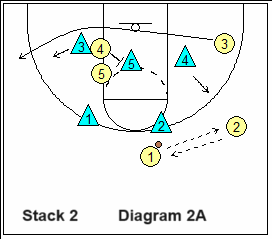
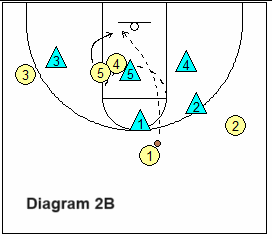
"Stack-3"
Use this option as a counter for when the defense overplays to stop the action from O4 and O5 (Stack-1 and Stack-2). O1 passes to O2 and O2 passes back to O1 as usual, and O3 cuts under to the left corner area. After passing back to O1, O2 lazily slides down to the corner (diagram 3A). O1 dribbles left. O4 and O5 back-screen the two inside defenders (diagram 3B), and O2 cuts in from the corner for a lob pass from O1.
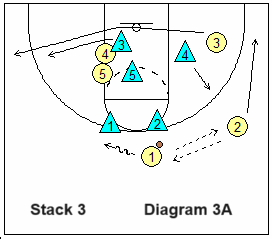
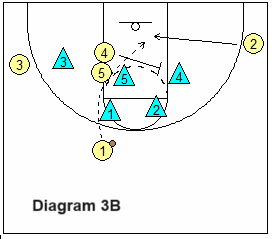
From Bryce Drew, Vanderbilt University Head Coach "- Bryce Drew: Multiple Strategies for Attacking Zone Defenses":
More plays - get the complete article in the Premium Members section or the Playbook download.Sign up now!
The complete article also includes:
- Iowa
- 21 and 31
- Indiana
- UConn
- UCLA and UCLA-22
- Raptors
- Hornets
- Wolf
- Pacers
Related pages:
- Kansas Zone Plays
- Michigan State's Sets/Plays (five zone plays presented)
- Tom Izzo's Fist-Down Zone Play
- Gap Attack Zone Play